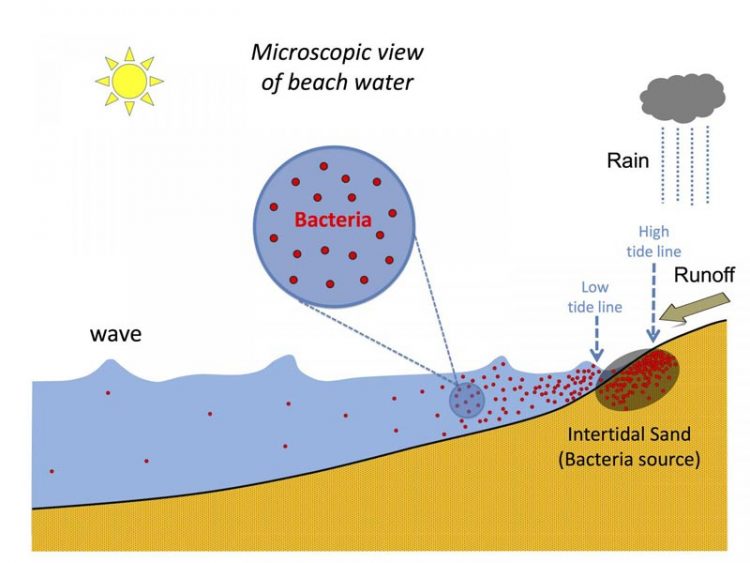New tool better protects beachgoers from harmful bacteria levels

This infographic shows a microscopic view of beach water. Credit: Feng, et. al.
An international team, led by researchers at the University of Miami (UM) Rosenstiel School of Marine and Atmospheric Science, has developed a new, timelier method to identify harmful bacteria levels on recreational beaches. The new model provides beach managers with a better prediction tool to identify when closures are required to protect beachgoers from harmful contaminates in the water.
“The development of this new model has allowed us, for the first time, to estimate contamination levels on beaches subject to nonpoint source pollution, in particular from beach sand and runoff from storms,” said the study's authors.
The new method provides beach health managers with an easily accessible computer model to predict harmful bacteria levels from all potential pollution sources. The team optimized and validated their model using a 10-day monitoring dataset from the popular Virginia Beach in Miami, Florida. The predictive model uses information on waves, tides, rainfall and solar radiation to more accurately predict harmful bacteria concentration and movement along the shore allowing for improved beach management decision-making.
Federal and state laws require water monitoring of fecal indicator bacteria, such as enterococci and fecal coliform, at recreational beaches to protect beachgoers from harmful water contamination levels. Excess levels of these harmful bacteria prompt beach advisories and closures to minimize human health risks. Water contamination from fecal indicator bacteria can result from “point-source” pollution, such as a sewage outfall, or “nonpoint source” pollution from storm-water runoff, or animal and human inputs.
Current methods assess fecal bacteria contamination levels by direct sampling of water from beaches, as well as by using complex computer modeling. Direct sampling methods requires a one-day laboratory analysis to access the health risk to humans at a particular beach. Therefore, a 24 to 48 hours wait period after sampling is required before any beach closure or advisory is issued. In addition, the current computer-based model requires high computing power, which is often inaccessible to beach closure decision managers, and can only predict contaminates from known sources of pollution, such as sewage outfalls.
The National Science Foundation-funded study, titled “A predictive model for microbial counts on beaches where intertidal sand is a primary source,” was published in the May 15 issue of the journal Marine Pollution Bulletin. The co-authors include: UM Rosenstiel School alumnus Zhixuan Feng of Woods Hole Oceanographic Institution; Ad Renier, Brian K. Haus, and John D. Wang of the UM Rosenstiel School of Marine and Atmospheric Science; Helena M. Solo-Gabriele of the UM School of Engineering; Lora E. Fleming of the university of Exeter Medical School. NSF Awards: OCE-0432368, OCE-0911373, OCE-1127813
###
About the University of Miami's Rosenstiel School
The University of Miami is one of the largest private research institutions in the southeastern United States. The University's mission is to provide quality education, attract and retain outstanding students, support the faculty and their research, and build an endowment for University initiatives. Founded in the 1940's, the Rosenstiel School of Marine & Atmospheric Science has grown into one of the world's premier marine and atmospheric research institutions. Offering dynamic interdisciplinary academics, the Rosenstiel School is dedicated to helping communities to better understand the planet, participating in the establishment of environmental policies, and aiding in the improvement of society and quality of life. For more information, visit: http://www.
Media Contact
All latest news from the category: Life Sciences and Chemistry
Articles and reports from the Life Sciences and chemistry area deal with applied and basic research into modern biology, chemistry and human medicine.
Valuable information can be found on a range of life sciences fields including bacteriology, biochemistry, bionics, bioinformatics, biophysics, biotechnology, genetics, geobotany, human biology, marine biology, microbiology, molecular biology, cellular biology, zoology, bioinorganic chemistry, microchemistry and environmental chemistry.
Newest articles

Superradiant atoms could push the boundaries of how precisely time can be measured
Superradiant atoms can help us measure time more precisely than ever. In a new study, researchers from the University of Copenhagen present a new method for measuring the time interval,…

Ion thermoelectric conversion devices for near room temperature
The electrode sheet of the thermoelectric device consists of ionic hydrogel, which is sandwiched between the electrodes to form, and the Prussian blue on the electrode undergoes a redox reaction…

Zap Energy achieves 37-million-degree temperatures in a compact device
New publication reports record electron temperatures for a small-scale, sheared-flow-stabilized Z-pinch fusion device. In the nine decades since humans first produced fusion reactions, only a few fusion technologies have demonstrated…





















